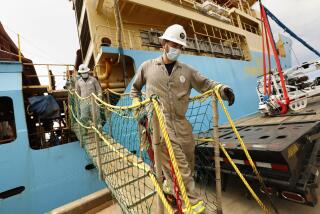Bottom trawling flattens seafloor
- Share via
Fishing trawlers that scrape the seafloor with nets are altering the submarine landscape and may affect sensitive marine ecosystems, according to researchers.
Likening the effect of bottom trawling to agriculture plowing or forest clear-cutting on land, marine scientists say the practice has flattened undersea slopes across the globe. In the process, the fishing equipment threatens the diversity of sea life by altering their habitat.
The study, published Wednesday in the journal Nature, listed 24 coastal areas that had probably been altered by trawling, including fisheries off Northern California and in Morro Bay. The areas measured between 1,200 and 4,500 feet deep.
As a case study, lead author and marine geologist Pere Puig and colleagues examined a shrimp fishing region off Spain’s Mediterranean coast. Puig, of Barcelona’s Institute of Marine Sciences, used remote-controlled submarines to document gouged and flattened areas along trawling routes.
While undersea erosion and other natural processes cut deep valleys into the continental slope, Puig and his team noted that silt had been dumped into one of these canyons by trawling gear.
The practice of deep-sea trawling has been criticized for its impact on sea life, but Puig’s study was the first to examine trawling’s effect on undersea terrain. Although it remains unclear what the long-term effects could be, authors suggested that they would probably mirror changes that had occurred on land.
“Changes in land use during the 20th century resulted in a reduction of landscape diversity almost everywhere through the spreading of arable land and timber plantations, which led to gradual disappearance of both major and minor elements of topography,” the authors wrote. “Bottom trawling has been compared to forest clear-cutting, although our results suggest that a better comparison might be intensive agricultural activities.”





